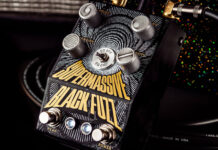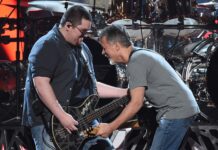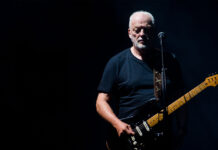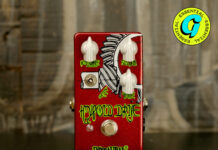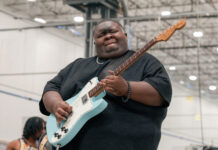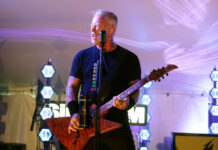
Five times the Hives were the best band in the world (according to the Hives)
Do you like watching people fail after they have talked themselves up? Of course you do, you’re human. Do you like watching the Hives fail after they have talked themselves up? Well, you’re still waiting to find out, aren’t you? Their new record The Hives Forever Forever The Hives won’t give you any closure on that front.
Arriving more than three decades on from the suited-and-booted iconoclasts’ formation in Fagersta, Sweden, it is another flex by a band who are still rattling along at high speed, powered by volume, treble and battleworn chemistry. “It kind of feels like we’re on an upward trajectory,” guitarist Nicholaus Arson, aka Niklas Almqvist, says and, remarkably, there’s a lot more than bravado behind his assessment.
READ MORE: The Beths Pick Their Five Most Honest Guitar Records Of All Time
The Hives’ seventh album is, in some ways, a reaction to what came before it. By landing barely two years after the release of The Death of Randy Fitzsimmons, it course-corrects the yawning, decade-plus wait for a follow up that took hold after 2012’s Lex Hives. It’s a record by a touring group, its songs gathering momentum on the road and reaping the rewards of hundreds of on-stage reps. It’s about striking while the iron is hot.
“Recording when you’ve toured for two years is both good and bad,” Almqvist says. “It’s kind of fatiguing, but you have a band that sounds good, you know? You have to rehearse the songs, but your timing is still intact. You don’t have to practise to start sounding like the band that you are. It’s already sorted.”
The Hives Forever Forever The Hives pulls together two threads in the Hives’ story — it’s both a high-gloss rock album by some old heads and also a lean, mean garage-punk LP by musicians who’re still connected to their roots. It’s their attempt at making an “arena record”, inspired by their experiences opening for AC/DC and the Rolling Stones, but in executing that it seems like they’ve realised that a Hives arena record is actually just a Hives record assembled in a manner that pays attention to the basics: knife-wielding riffs, shoutalong hooks and a remorseless rhythm section.
Image: Press
“What’s an arena record for us?” Almqvist asks. “Maybe Back in Black? It’s pretty traditional stuff. Traditional-sounding drums, traditional-sounding guitars, great sounds. Maybe that was our take on it — you don’t have to do so much weird stuff if you’re going to try to make a classic rock record.”
Like its immediate predecessors, it was partly recorded at Stockholm’s Riksmixningsverket, the studio co-founded by ABBA’s Benny Andersson, while there was also creative input from Mike D, he of Beastie Boys fame. Crucially, though, it was tracked with Pelle Gunnerfeldt, whose gonzo style characterised their first three records. It’s the first time he’s produced a full LP for the Hives since 2004, with everyone from Pharrell Williams to Josh Homme having a crack in the intervening years, even if he’s steadfastly kept a finger in the pie, whether that’s as a mixer, engineer or sounding board.
Here, there’s energy and grit beyond what might be expected from a band this deep into their career, a youthfulness that bursts from Paint A Picture’s ringing chords and the blown out swagger of Enough is Enough. “Pelle’s always been around,” Almqvist says. “Kind of like us, in a way, he’s in a good spot right now. He’s making great sounding music — he’s done magical things with Viagra Boys. We’re in good shape. The rest of it is work. You work until the record sounds good. A studio is a studio. It can be anywhere, really. I don’t think we trust magic as much as other people do. For us it’s always work. That’s just the grind, you know?”
Image: Press
Reflecting the momentum that led them into the studio and this direct approach to documenting these songs, Almqvist and his co-guitarist Vigilante Carlstroem (Mikael Karlsson) threw their live set ups at the problem. “We probably used our regular guitars way more than we ever did before,” Almqvist says. “I mean, we probably haven’t used them this much since the first record, when we had no other guitars. The second record we recorded in Pelle’s studio, and he’s always collected Travis Beans and Kramers with metal headstocks, stuff like that. We used a lot of his gear on that record and from Veni Vidi Vicious onwards we played anything, really, that was in the studio. Anything that sounded good.”
While Karlsson has pinwheeled between his one true love, a ‘59 Epiphone Coronet, plus a Les Paul, and a Flying V along the years, Almqvist’s choices have remained decidedly Telecaster-shaped. His Sundberg Arsonette, a guitar of his own design that is halfway between a Tele and a Firebird, sat this one out, but his 1970s Telecaster Custom, a battered and bruised road-dog with just a fizzing stock bridge pickup, was in full flow. Amp-wise, The Hives Forever Forever The Hives leans on another old face: a Standel Custom that’s been around since the Veni Vidi Vicious era. “This is where it gets a bit dull to talk to me about guitars, because I picked them 25 years ago and ran with it,” he says.
And how. The Hives are older now, but thankfully they’re not wiser. No prog song suites here, no plaintive reflections on mortality, just ripping garage-rockers. In that spirit, we asked Almqvist to pick his five favourite Hives riffs or, to put it another way, to tell us five times the Hives were the best band on the planet. Unsurprisingly, he found it quite difficult to narrow it down. “I came to the conclusion that there are a whole bunch of riffs that I really like,” he says.
“A lot of them are older, I guess,” he continues. “They kickstarted things for us, they were riffs we managed to craft into songs early on, when we were finding our sound. If you’re a high jumper, the first time you clear 2.40, that’s amazing, but when you’ve done it 20 times the novelty is going to wear off a little bit. That first time, when you’ve nailed it, is a good feeling.”
Main Offender (Veni Vidi Vicious, 2000)
“People always ask me, ‘What’s your favorite song to play live?’ And I always say Main Offender. I really love that little guitar intro going into what’s probably one of my favorite riffs. It’s very much an updated version of the Sonics, one of my favorite bands. We always try to be like a punk band with AC/DC riffs, you know? Maybe a punk riff, but they would have that start and stop element. Main Offender is totally one of those.”
Die, All Right! (Veni Vidi Vicious, 2000)
“It’s on that record, too. The verse from Die, All Right! is one of my favourite riffs. It’s also very Sonics inspired. Main Offender, or Die, All Right! are riffs. I guess some will say Hate To Say I Told You So but it’s more like chords in a sequence. Is that a riff? I guess it is, but it’s not like a blues riff or a boogie riff or something. I like Hate To Say I Told You So because it really gave us a career, even though it wasn’t the song that I thought would give us a career. I thought that was probably going to be Die, All Right!.”
A.K.A. I-D-I-O-T (Barely Legal, 1997)
“I really like A.K.A. I-D-I-O-T. The intro bit is really good, and I really like both the verse and the chorus. On that record, too, I really like Here We Go Again. That’s a great riff. Barely Legal was the first record where I felt, ‘This is so cool, this is what I want our music to sound like.’ I remember listening to the master in my basement on one of those CD Walkmans. It was so great [working with] Pelle Gunnerfeldt. He was probably the only guy recording music [in Stockholm] who had ever heard about the New Bomb Turks.”
Bogus Operandi (The Death of Randy Fitzsimmons, 2023)
“To me, that’s a sort of a traditional Hives riff. What I like about it, too, is that it evolves during the song. There’s a key change, and there’s that bit at the end where you sort of cut the riff in half, and you play that outro bit. There’s a take on it through that middle eight, or whatever you want to call it, where you let it set sail and send it out to sea for a bit.”
Bad Call (The Hives Forever Forever The Hives, 2025)
“I should pick a favorite from the latest record, too. There are a lot of great riffs on there. Hooray Hooray Hooray has a great riff, Paint a Picture has a great riff, but I think my favourite is the verse to Bad Call. It’s the drums that are the star in that one, the chords accent the drums and then travel through the song. If it was just the drums, maybe you’d get a bit bored on your journey towards the chorus.”
The Hives’ The Hives Forever Forever The Hives is out on August 29 through PIAS.
The post Five times the Hives were the best band in the world (according to the Hives) appeared first on Guitar.com | All Things Guitar.
Source: www.guitar-bass.net

